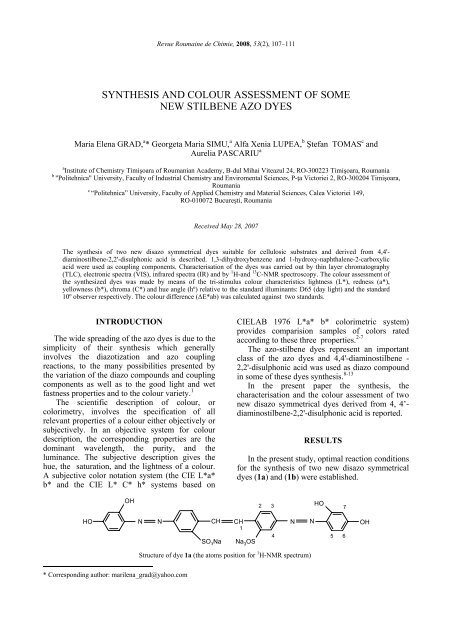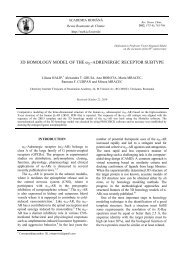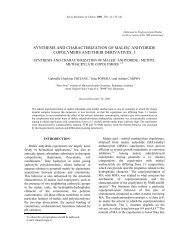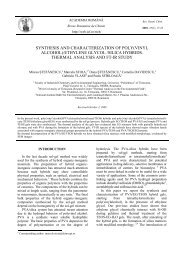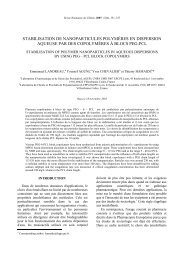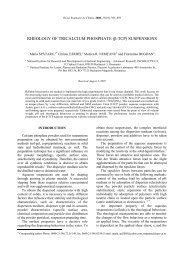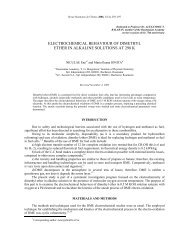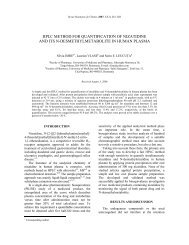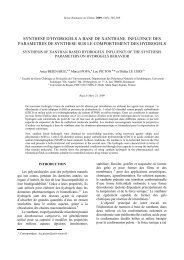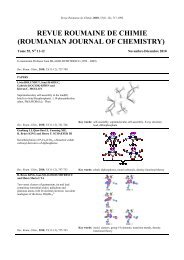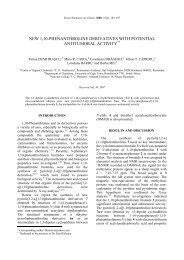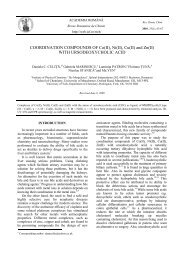synthesis and colour assessment of some new stilbene azo dyes
synthesis and colour assessment of some new stilbene azo dyes
synthesis and colour assessment of some new stilbene azo dyes
- No tags were found...
Create successful ePaper yourself
Turn your PDF publications into a flip-book with our unique Google optimized e-Paper software.
110 Maria Elena Grad et al.The polar parameters C*, hº derivated from thea* <strong>and</strong> b*values 15 are alternatively used. C*(chroma) represents the <strong>colour</strong> saturation <strong>and</strong> hº(hue angle) express the hue <strong>colour</strong> <strong>and</strong> lead to amore intuitive representation <strong>of</strong> a <strong>colour</strong>.One measure <strong>of</strong> the difference in <strong>colour</strong>between two stimuli is the Euclidian distance(∆E*ab), between the two points in the CIELABthree-dimensional space. The lightness (L*) values<strong>of</strong> the dye 1a shown in table 2 range from 30.47 to31.29 in the case <strong>of</strong> mixture with the blackpigment (P.Bk 7) <strong>and</strong> from 46.10 to 75.24 in thecase <strong>of</strong> the white pigment (P.W.6) respectively.The lightness (L*) lower values <strong>of</strong> dye 1b shownin table 3 indicate a reduced light reflexioncapacity <strong>of</strong> this compound.In the white pigment mixture, dye 1b is redder(increased values <strong>of</strong> a*) compared to the dye 1a. Inthe black pigment mixture, dye 1a is redder(increased values <strong>of</strong> a*) compared to the dye 1b<strong>and</strong> a <strong>colour</strong> shifting to blue (negative values <strong>of</strong>b*) to the later is recorded. The <strong>colour</strong> huemodification can be easier observed from the hueangle values (hº) presented in Table 2 for dye 1a<strong>and</strong> in Table 3 for dye 1b.Saturation referes to the richness <strong>of</strong> a hue ascompared to a gray <strong>of</strong> the same lightness. Thechroma (C*) very low values <strong>of</strong> dye 1b, in theblack pigment mixture reveal an impure <strong>colour</strong>.A comparision between the <strong>colour</strong> difference(∆E*ab), values presented in table 2 for dye 1a <strong>and</strong>in table 3 for dye 1b suggests a good <strong>colour</strong>ingpower <strong>of</strong> the dye 1a in the white pigment mixture<strong>and</strong> the black pigment mixture respectively.EXPERIMENTALThe chemical used in this work were obtained fromChimopar Bucureşti, Merck, AcrŌs Organic, Monicolor, S. C.Azur S.A.The thin layer chromatographic (TLC) data were takenfrom silica gel plates (Merck 60-F254). Electronic spectra(VIS) were recorded on a Perkin Elmer λ12 spectrophotometerfor dye 1a <strong>and</strong> on a CECIL CE 7200 spectrophotometer fordye Ib. The 1 H-NMR <strong>and</strong> 13 C-NMR spectra were recorded ona BRUKER Avance DRX-400 spectrometer. The infrared (IR)spectra were recorded on a Shimadzu FT/IR 8900 spectrometer.Synthesis <strong>of</strong> dye 1a <strong>and</strong> 1b1. Bis-di<strong>azo</strong>tization <strong>of</strong> 4,4'-diamino<strong>stilbene</strong>-2,2'-disulphonicacid2.1 g 4,4'-diamino<strong>stilbene</strong>-2,2'-disulphonic acid (0,005 mol)were suspended in 10 mL distilled water. After 5 minutes <strong>of</strong>stirring 1.1.mL 30% NaOH aqueous solution were aboveadded. The reaction mixture was cooled to 5ºC <strong>and</strong> treatedwith 3 mL (0.03 mol) 32% HCl. The bis-di<strong>azo</strong>tisation reactionwas carried out by the adding <strong>of</strong> 0.75 g (0.01 mol) NaNO 2solid to the 4,4'-diamino<strong>stilbene</strong>-2,2'-disulphonic acid suspension.The pH value <strong>of</strong> the mixture was kept around 1. After the NaNO 2addition the mixture was stirred for another 20 minutes <strong>and</strong> theexcess <strong>of</strong> the nitrous acid was decomposed by urea. Finnaly theobtained bis-di<strong>azo</strong>nium salt was filtered out <strong>and</strong> the precipitatewas washed with distilled water.2. Bis-<strong>azo</strong> coupling reactionsA quantity corresponding to 0.011 mol <strong>of</strong> couplingcomponents (e.g. 1,3-dihydroxybenzene <strong>and</strong> 1-hydroxynaphthalene-2-carboxylicacid) was dissolved in 10% NaOHaqueous solution. The bis-di<strong>azo</strong>nium salt obtained in step 1was suspended in 20 mL distilled water <strong>and</strong> was added to thealkaline solution <strong>of</strong> 1,3-dihydroxybenzene.In the case <strong>of</strong> dye1b coupling reaction the bis-di<strong>azo</strong>nium salt suspension wastreated with the alkaline solution <strong>of</strong> 1-hydroxy-naphthalene-2-carboxylic acid. The reaction mixture was stirred another3 hours at 8ºC <strong>and</strong> the pH was maintained in the range <strong>of</strong> 7-8by periodic addition <strong>of</strong> 10% Na 2 CO 3 aqueous solution. Thecoupling reaction was controlled by the drop reaction. The dye1a precipitated after 15 hours at pH=8, <strong>and</strong> was separated byfiltration <strong>and</strong> washed with methanol. The dye 1b wasseparated by precipitation <strong>of</strong> the dye from the acid solution(pH=5.5) obtained by addition <strong>of</strong> 10% HCl solution. Theprecipitate was washed with anhydrous ethyl ether. Finally thecrude <strong>dyes</strong> were purified by crystalization from ethanol. Theobtained compounds were characterisated by thin layerchromatography (TLC), infrared spectra (IR), electronicspectra (VIS) <strong>and</strong> by 1 H-<strong>and</strong> 13 C-NMR spectroscopy.Colour analysis <strong>of</strong> dye 1a <strong>and</strong> 1bThe <strong>colour</strong> spectrophotometric study <strong>of</strong> the <strong>new</strong>synthesized <strong>azo</strong>-<strong>stilbene</strong> <strong>dyes</strong> was performed on a Minolta3200d spectrophotometer. The samples differentiated by thedye concentration, the white pigment (P.W.6) <strong>and</strong> blackpigment (P.Bk.7) respectively <strong>and</strong> were layed on a cellulosicsubstrate (wood). Further details on the general procedure maybe found in references. 16 Using a D65 illuminant <strong>and</strong> a 10ºobserver, the CIELAB coordinates, the hue angle (hº), <strong>and</strong> thechroma (C*) were determinated for each sample partly. The<strong>colour</strong> difference (∆E*ab) was calculated confronted by twost<strong>and</strong>ards.Aknowledgements: This work was supported by a CNCSISgrant type A, CNCSIS code 1443, Gr.71/2006, nr.66/ 09. 05.2007 <strong>of</strong> the Roumanian Ministry <strong>of</strong> Education <strong>and</strong> ResearchREFERENCES1. H. Zollinger, "Color Chemistry: Synthesis, Properties <strong>and</strong>Applications <strong>of</strong> Organic Dyes <strong>and</strong> Pigments", 3 rd editionWiley-VCH, Zűrich, 2003, p. 220.2. T. Tłaczała <strong>and</strong> A. Bartecki, Dyes Pigm., 1995, 28, 47-56.3. N. Koprivanac, S. Papić, A. Hergold- Brundić, A. Nagl,D. Parac-Osterman <strong>and</strong> Z. Grabarić, Dyes Pigm., 1997, 35,57-68.4. C.C. Chen <strong>and</strong> I. J. Wang, Dyes Pigm., 1991, 15, 69-82.5. I. Grabchev, P. Meallier, T. Konstantinova <strong>and</strong>M. Popova, Dyes Pigm., 1995, 28, 41-46.6. J. Hu, P. Skrabal <strong>and</strong> H. Zollinger, Dyes Pigm., 1987, 8,189-209.
Stilbene <strong>azo</strong> <strong>dyes</strong> 1117. D. Mijin, G. Uśćumlić, N. Periśić-Janjić, I. Trkulja, M.Radetić <strong>and</strong> P. Jovanćić, J. Serb. Chem. Soc. 2006, 71,435-444.8. H. Eilingsfeld, G. Hansen, G. Seybold <strong>and</strong> G. Zeidler, DEPat. 2901654, Jul.31, 1980; cf. Chem. Abstr., 1980, 93,201645.9. A. Fasciati, DE Pat. 2926184, Jan.10, 1980; cf. Chem.Abstr., 1980, 92 , 199744.10. H. Chiaki, S. Matsubara <strong>and</strong> T. Naito, JP Pat.6232150,Feb. 12, 1987; cf. Chem. Abstr., 1987, 107, 24081.11. C.Vogel <strong>and</strong> H. Wicki, DE Pat. 2637992, Mar. 17, 1977;cf. Chem. Abstr., 1977, 86, 173062.12. E. J. . Radigan Jr, L. V. Isganitis, W. E. Solodar <strong>and</strong> K.B. Gundlach, U.S. Pat. 5360472 Nov. 01, 1994; cf. Chem.Abstr., 1995, 128, 58792.13. Y. C. Chao <strong>and</strong> S. S. Yang, Dyes Pigm., 1995, 29, 131-138.14. H. Sanielevici <strong>and</strong> F. Urseanu, "Sinteze de ColoranţiOrganici", vol.2, Editura Tehnică, Bucureşti 1987, p. 287.15. S.Popa, D. Jurcău, C. Jurcău <strong>and</strong> N. Pleşu, "PigmenţiOrganici", vol. I, Editura Orizonturi Universitare,Timişoara, 2005, p. 91.16. M.E. Grad <strong>and</strong> S. Popa, Scien. <strong>and</strong> Techn. Bull. <strong>of</strong> Univ.A. Vlaicu Arad, 2006, 11, 42-45.


